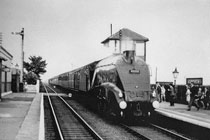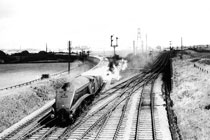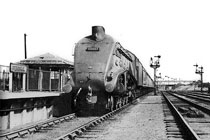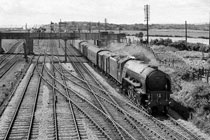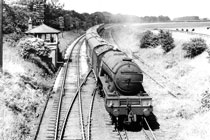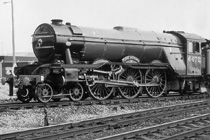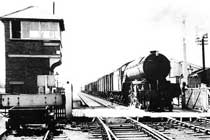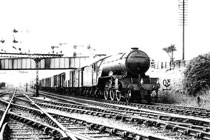Washington County Durham
HOME WHAT'S WHERE BACK TO RAILWAYS
Confessions of
An Usworth Trainspotter!
Memories of the Fabulous Steam Locomotives that once graced The Leamside Line
1. Sundays at Usworth, in The Fields next to the Leamside Line
( Late 50s / Early 60s )
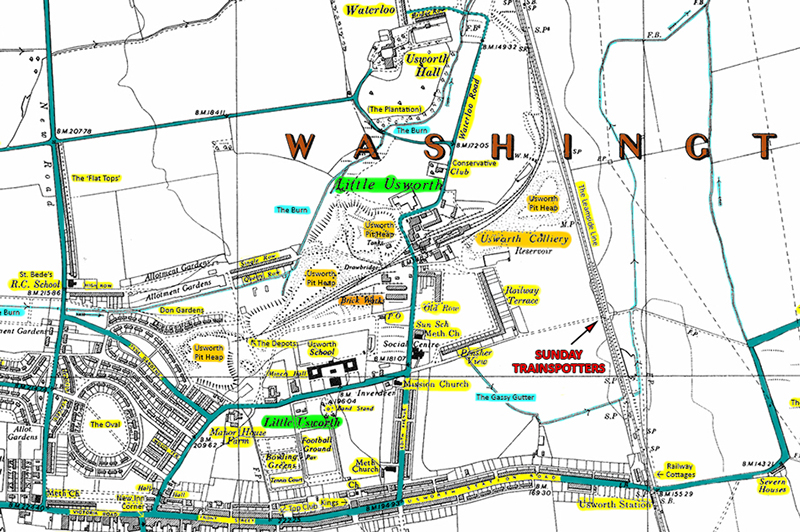
When maintenance work was carried out on the London to Edinburgh main line, the rail traffic was diverted via Usworth Station.
A Sunday's Trainspotting at Usworth
On Sundays in the late 1950s / early 1960s, rail traffic was regularly diverted from the North-East main line (which crossed Chester-le-Street Viaduct) onto the Leamside Line, which passed over the Victoria Viaduct and through Washington & Usworth Stations. This allowed maintenance work to be carried out on the main-line and gave Washington residents the opportunity to see some famous steam engines in action. The above map shows where dozens of young lads used to congregate, in the fields east of Pensher View and Railway Terrace, to watch these magnificent machines pass by. Football games would be temporarily suspended when an approaching train was spotted in the distance, especially at the cry ... "It's a Streak!"
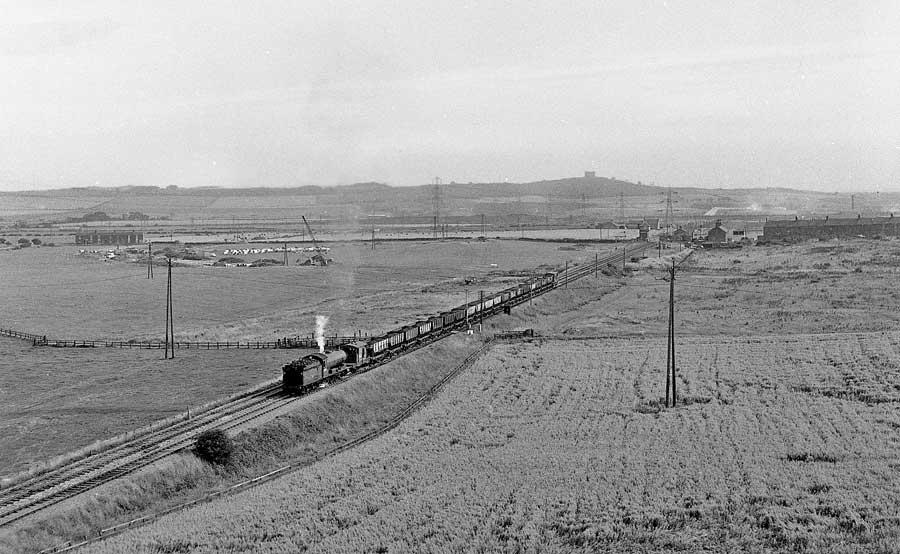
Steam Engine with Coal Wagons crossing the Footpath labelled 'Sunday Trainspotters' on above Map.
The Leamside Line Railway. Picture taken from the Top of the adjacent Usworth Pit Heap.
Severn Houses - Bull Field - Penshaw Monument - Usworth Station - Chemical Works Spoil Heap.
[ Photo: Thanks to Adrian Lupton. ]
2. Ian Allan's Books listed every Steam Locomotive in Great Britain
( It was possible to see any of the magnificent A1, A2, A3 or A4 Steam Engines passing through Usworth & Washington.)
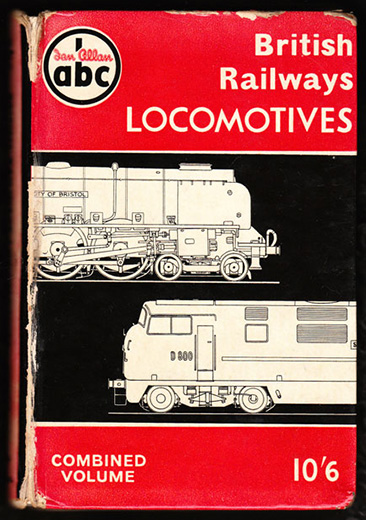
The 'Combined Version' listed all BR locomotives.
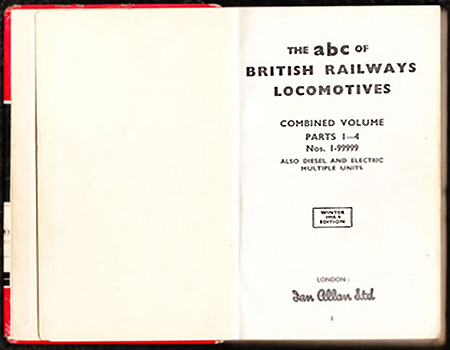
James Gill's personal Ian Allan book - Winter 1958/59 Edition.
Why buy the 10s/6d Version?
During the early 1960s, my mate Fernie (who lived in Edith Avenue) and I were members of the Tyne-Tees Locospotters' Club. They used to organise loco works visits, mostly in the North of England, and usually on a Sunday. I remember one such trip took us by coach to Carlisle, where we visited the loco sheds at Kingmoor and Upperby. Other trips by rail took us to Leeds, York and even London! And this is why I needed the 10s/6d version. Note the price. How could I save up that much? Well, my father rarely gave me money, but he did allow me to earn some by doing jobs such as shovelling his 'colliery allowance' into our coal house, or filling up his allotment's 35 gallon water butts from the nearby Burn. That taught me about the value of money and how to manage it!
3. Express Steam Locomotives - Class A4 & Class A3
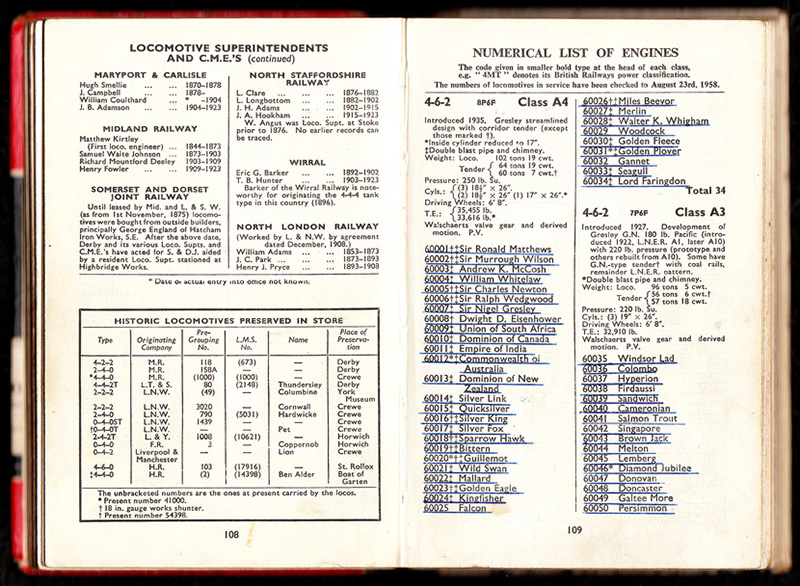
Ian Allan's British Railway Locomotives, Combined Volume - Winter 1958/59 Edition
Sir Nigel Gresley's engineering masterpieces - Class A4 Locomotives - universally known among British locospotters as 'The Streaks'.
Note: A4 No. 60022 - Mallard, the fastest steam locomotive in the world at 126 mph.
4. Express Steam Locomotives - Class A3 (cont.), Class A1 & Class A2
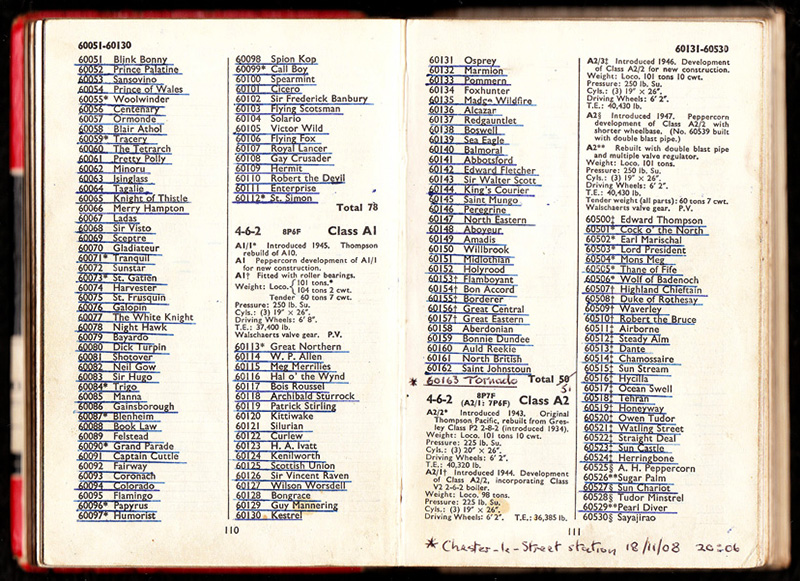
Ian Allan's British Railway Locomotives, Combined Volume - Winter 1958/59 Edition
Note: A3 No. 60103 - Flying Scotsman and A1 No. 60163 - Tornado, which was built between 1994 & 2008.
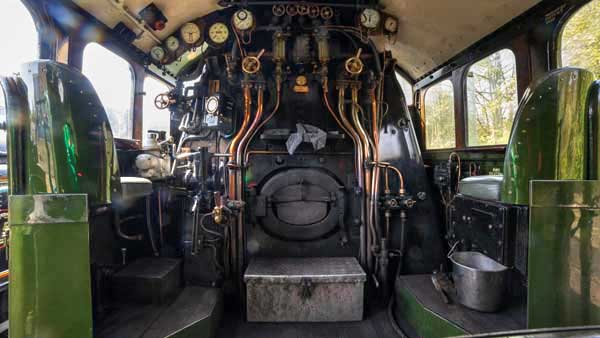
Cockpit of Refurbished Flying Scotsman
[ Picture: Thanks to Keighley & Worth Valley Railway, Haworth, West Yorkshire. ]
One Saturday in the Early 1960s my mate Hugh Furnevel (Fernie) and I were standing on the Main Platform of Newcastle Central Station.
Unexpectedly, No. 60103, The Flying Scotsman, arrived from the King Edward Bridge and stopped at our Platform.
It was en route from London to Edinburgh. We raced up the platform to the Engine and ...
Guess what? The Driver invited us up into the Cockpit. Wow!
5. Express Steam Locomotives - Class A2 (cont.) & Others
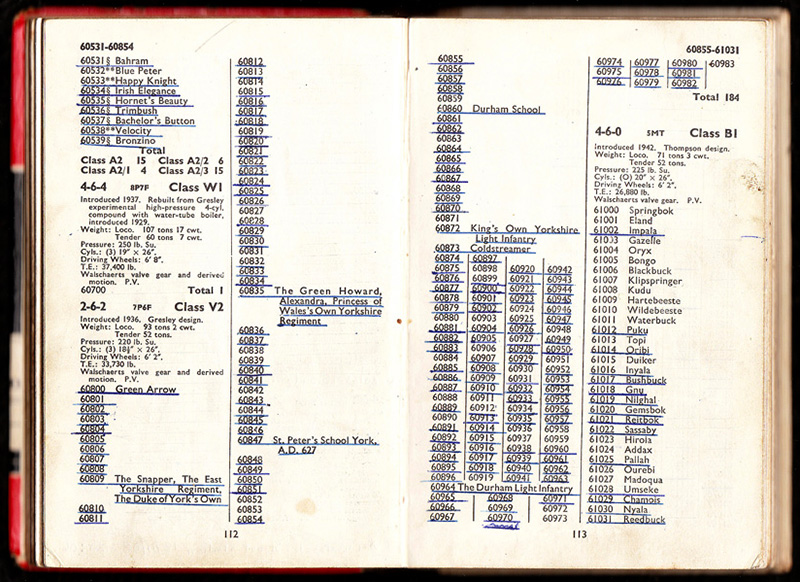
Ian Allan's British Railway Locomotives, Combined Volume - Winter 1958/59 Edition
Note: A2 No. 60532 - Blue Peter, V2 No. 60964 - The Durham Light Infantry, and W1 No. 60700 - The Unnamed Streak!
6. Class A4, Bittern disguised as Dominion of New Zealand
( ... with DNZ's original LNER number and livery )
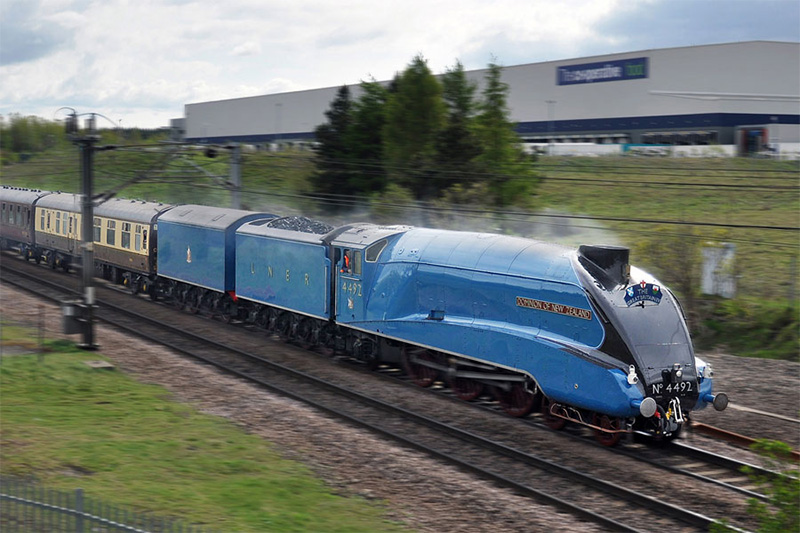
Bittern disguised as Dominion of New Zealand - passing Pelaw Grange Greyhound Stadium, 3:25 p.m., Saturday 16th April 2011. [Photo: James Gill]
One of Sir Nigel Gresley's Magnificent A4s
I took this picture, at 3:25 p.m. on Saturday 16th April 2011, while standing on a 'grassy knoll' at Barley Mow (between Durham and Newcastle). I'd received a phone call from a mate of mine, Robert Brookes, who lives next to the main line just north of York Station. Paraphrasing his message, "There's something special heading north that you might want to try photographing." That was it. A challenge! I had about 45 minutes to walk to a place where I knew I'd be able to see it coming in the distance, whatever it was! I got there with 15 minutes to spare. I thought it was No.60013, Dominion of New Zealand which I'd seen many times before near this very spot back in the late 1950s. I was wrong; it was No. 60019, Bittern - in disguise!
During the winter of 2010/11 Bittern received maintenance which included being renamed & renumbered as its scrapped A4 classmate Dominion of New Zealand. This conversion also included repainting it in LNER garter blue, the fitting of Gresley's original side valances and the painting of its wheels in their original red colouring. Happily, Bittern had its name and original LNER number restored in time for the July 2013 exhibition of all six surviving Class A4 locomotives at the National Railway Museum in York. Why the change? Apparently, it had something to do with an important anniversary in New Zealand.
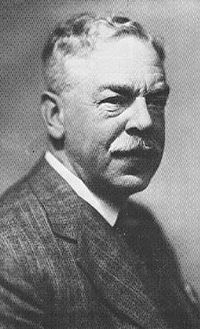
Sir Nigel Gresley
The Surviving A4s with their British Rail Nos:
60007 (LNER No.4498) Sir Nigel Gresley
60008 (LNER No.4496) Dwight D. Eisenhower
60009 (LNER No.4488) Union of South Africa
60010 (LNER No.4489) Dominion of Canada
60019 (LNER No.4464) Bittern
60022 (LNER No.4468) Mallard
Sir Nigel Gresley was Chief Mechanical Engineer of the London & North Eastern Railway (LNER) and designer of the Class A4 locomotives.
7. Local Historians: Colin E. Mountford & Ian S. Carr
( Colin was an Author of Local Railway Books. Ian was a renowned Railway Photographer. )
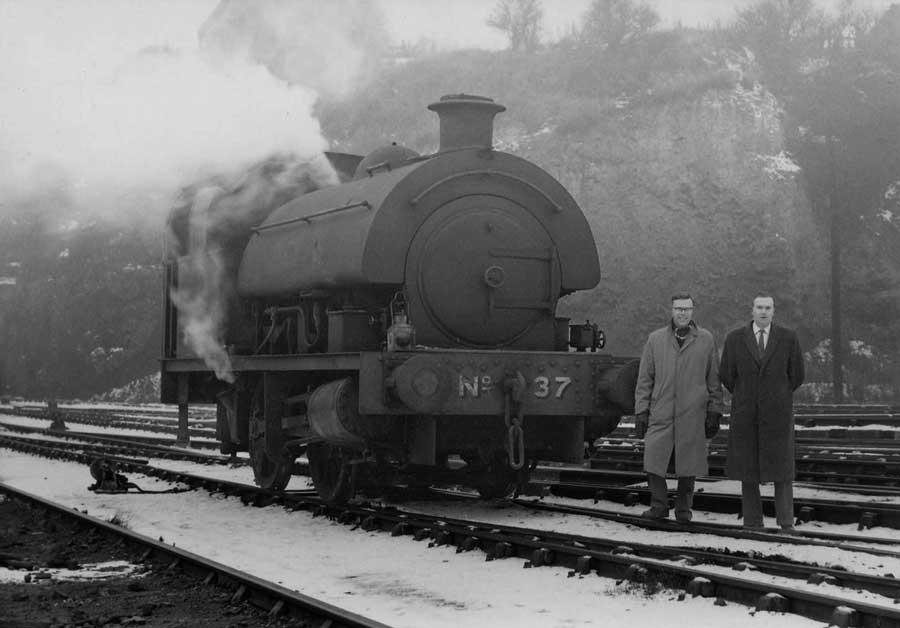
No. 37, the very last locomotive to leave Lambton Staithes, Sunderland - Colin & Ian - Date: 6th January 1967.
Colin stated that Ian had set up his camera on self-timer.
[ Photograph & Comment: Contributed by Malcolm Young, a friend of both Colin and Ian. Thanks Malcolm. ]
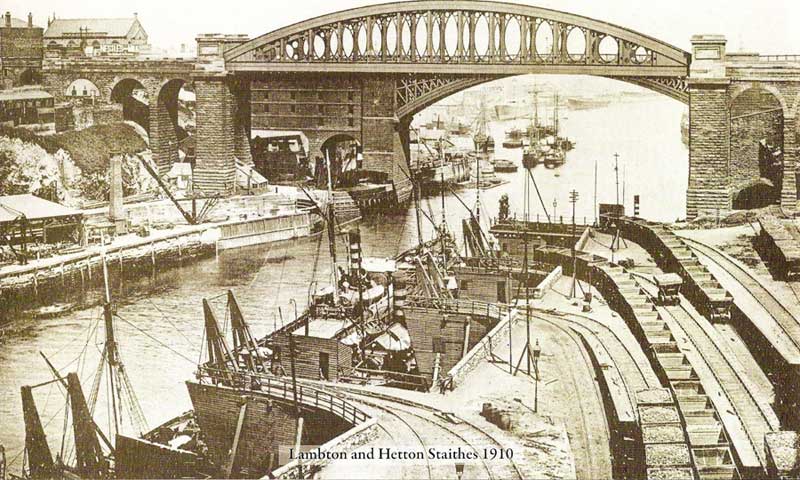
Lambton Staithes, looking downstream to Wearmouth Bridge
[ Photograph, Comments & Map below: Contributed by another one of our Local Historians, Keith Cockerill. Thanks Keith. ]
There were 4 'Lambton Staiths' on the R. Wear.
The above Staiths next to Wearmouth Bridge in Sunderland.
The Staiths at Low Lambton, immediately downstream from Victoria Bridge.
Nicholas Lambton's Staith at Biddick Haugh and Esquire Lambton's High Staith on the Lambton Estate.

BURLEIGH AND THOMPSON - 1737 MAP
Esquire Lambton's High Staith on the Lambton Estate
Nicholas Lambton's Staith at Biddick Haugh.
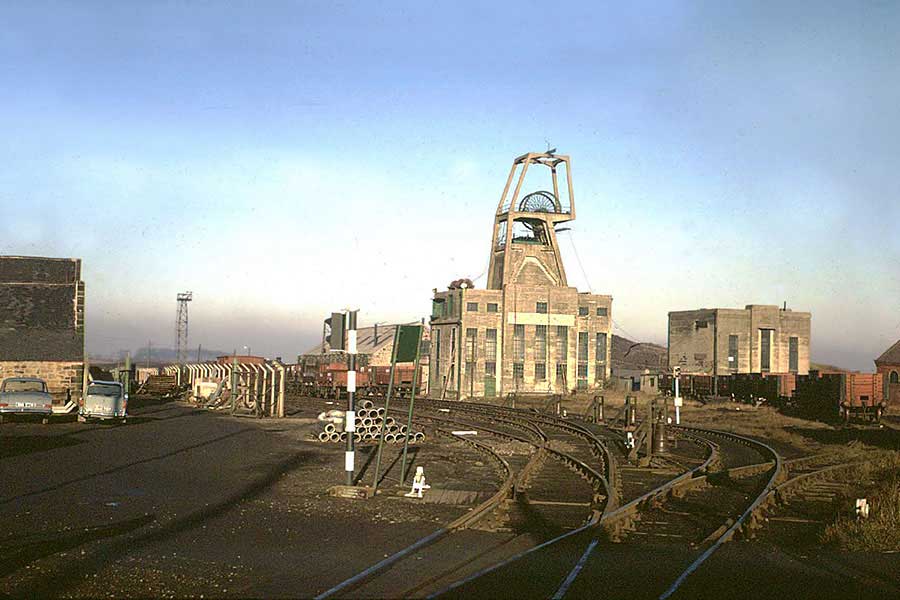
Bowes Railway at Springwell Colliery - 1967. This colliery closed in 1932.
[ Photographer / Industrial Historian / Author, Colin E. Mountford. ]
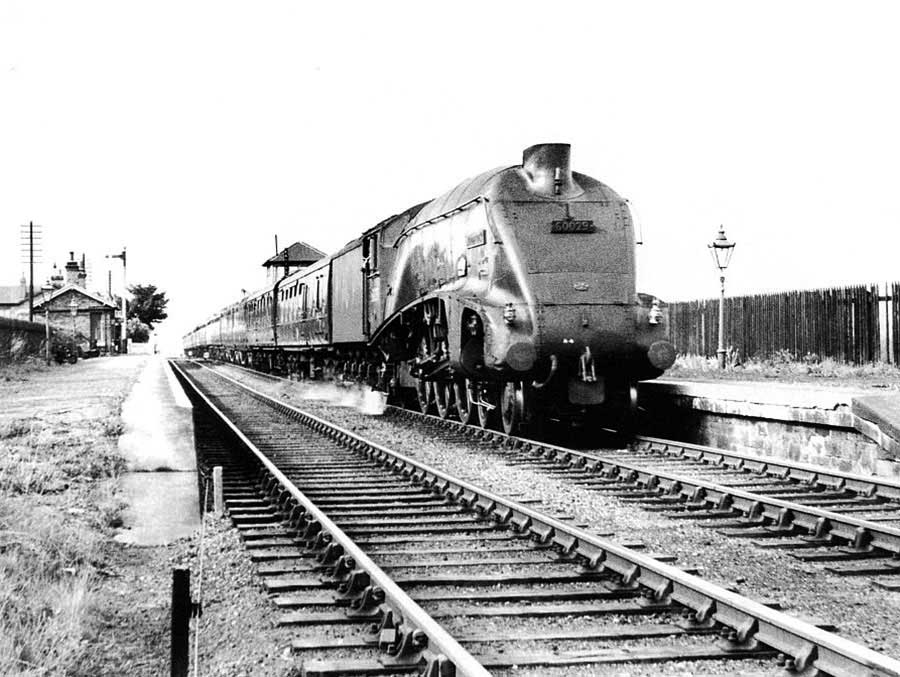
Usworth Station - 23rd August 1959
A Southbound Express (diverted from the East Coast Main Line) hauled by A4 No. 60029, Woodcock.
[ Photographer / Railway Historian, Ian S. Carr. ]

